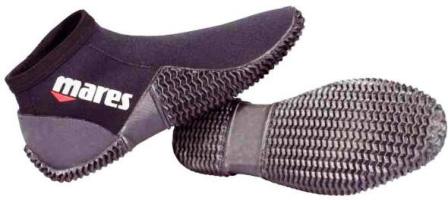Scuba Neoprene Boots and Booties
Scuba booties are like neoprene socks and some have a zipper on the side and hard bottoms so you can walk over rocks and other hard surfaces.
They protect your feet from cuts, burns and abrasions when walking on rocky beaches, rough boat decks and hot pavement.
If you are a cold water scuba diver they will help to keep your feet warm.
Booties can also prevent painful blisters from the heel strap of scuba fins that can rub directly against your heel when walking and diving.
Advantages
Wet suit boots - booties - have three main advantages over diving with bare feet.
 They will help to keep your feet warm in water below 21 degrees C, they protect against small cuts and grazes while walking to and from the water's edge, and they add comfort when wearing adjustable strap open-heel fins.
They will help to keep your feet warm in water below 21 degrees C, they protect against small cuts and grazes while walking to and from the water's edge, and they add comfort when wearing adjustable strap open-heel fins.
Typical boot construction consists of neoprene foam with semi-rigid soles molded from hard or semi-hard rubber, with textured surfaces for traction and protection.
In some models, the sole wraps over the heel and toe for protection, and longer wear.
Some boots have side-entry zippers, which helps when putting them on. Dive boots fit either by shoe size or S, M, L, XL, etc., and should be comfortable without being excessively large or small.
Even if you dive in exclusively tropical warm waters, you may still want to purchase wet suit boots - often called 'booties' - for a few important reasons.
- Warmth
- Protection
- Comfort
Boots Tip
Scuba booties come in different thicknesses for different water temperatures. If you are diving in tropical waters a lighter neoprene is preferred, whereas if you are a cold water diver you will want your booties to be made of thicker neoprene to keep your feet warm.
More Information |> Scuba Program for Beginners |> PADI Dive Courses |> Ask a PADI PRO |